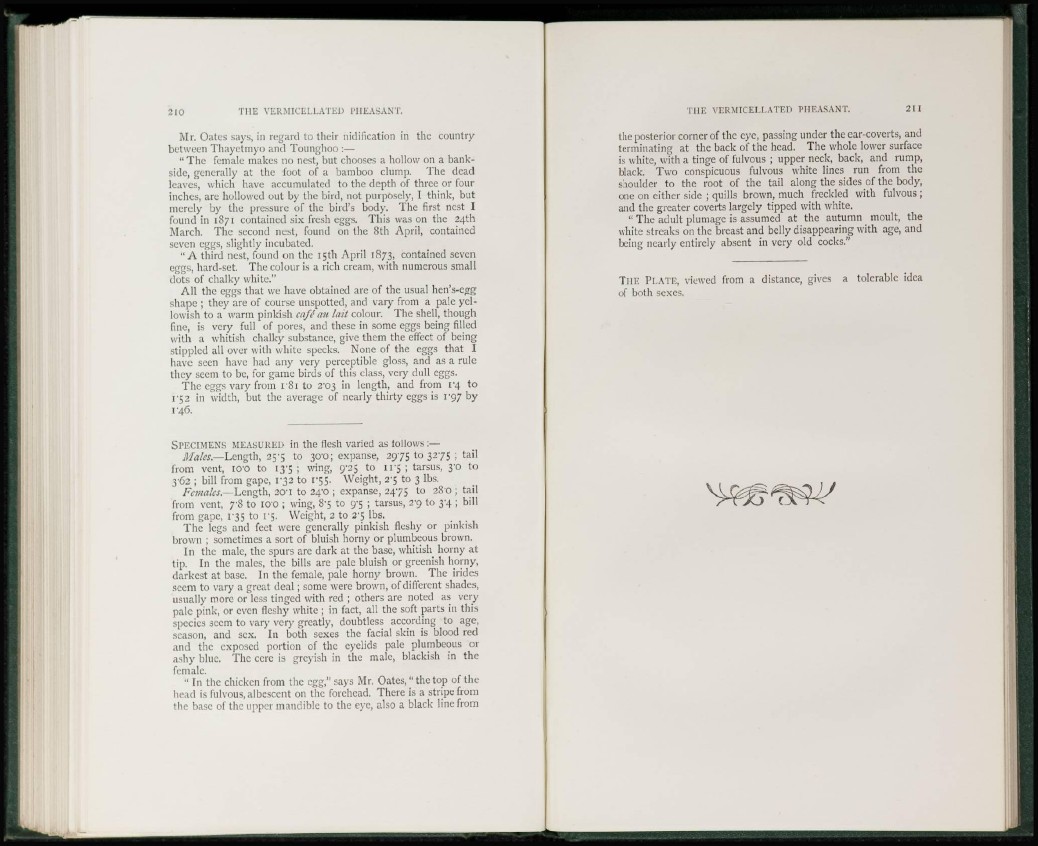
Mr. Oatcs says, in regard to their nidification in the country
between Thayctmyo and Tounghoo :—
" The female makes no nest, but chooses a hollow on a bankside,
generally at the foot of a bamboo clump. The dead
leaves, which have accumulated to the depth of three or four
inches, are hollowed out by the bird, not purposely, I think, but
merely by the pressure of the bird's body. The first nest I
found in 1871 contained six fresh eggs. This was on the 24th
March. The second nest, found on the 8th April, contained
seven eggs, slightly incubated.
" A third nest, found on the 15th April 1873, contained seven
eggs, hard-set. The colour is a rich cream, with numerous small
dots of chalky white."
All the eggs that we have obtained are of the usual hen's-egg
shape ; they are of course unspotted, and vary from a pale yellowish
to a warm pinkish café an lait colour. The shell, though
fine, is very full of pores, and these in some eggs being filled
with a whitish chalky substance, give them the effect of being
stippled all over with white specks. None of the eggs that I
have seen have had any very perceptible gloss, and as a rule
they seem to be, for game birds of this class, very dull eggs.
The eggs vary from i'8i to 2x13 in length, and from 14 to
i'52 in width, but the average of nearly thirty eggs is 1-97 by
146.
SPECIMENS MEASURED in the flesh varied as follows :—
Males.—Length, 25^5 to 30'o; expanse, 2975 to 3275 ; tail
from vent, i o o to 135 ; wing, 9'25 to 11-5 ; tarsus, 3'0 to
3'62 ; bill from gape, 1*32 to 1 "5 5. Weight, 25 to 3 lbs.
Females.—Length, 20'I to 24'o ; expanse, 2475 to 280 ; tail
from vent, 7'8 to IO'O ; wing, 8'5 to g'5 ; tarsus, 2'9 to 34 ; bill
from gape, 1 '35 to 1-5. Weight, 2 to 2'5 lbs.
The legs and feet were generally pinkish fleshy or pinkish
brown ; sometimes a sort of bluish horny or plumbeous brown.
In the male, the spurs are dark at the base, whitish horny at
tip. In the males, the bills are pale bluish or greenish horny,
darkest at base. In the female, pale horny brown. The irides
seem to vary a great deal; some were brown, of different shades,
usually more or less tinged with red ; others are noted as very
pale pink, or even fleshy white ; in fact, all the soft parts in this
species seem to vary very greatly, doubtless according to age,
season, and sex. In both sexes the facial skin is blood red
and the exposed portion of the eyelids pale plumbeous or
ashy blue. The cere is greyish in the male, blackish in the
female.
" In the chicken from the egg," says Mr. Oates, " the top of the
head is fulvous, albescent on the forehead. There is a stripe from
the base of the upper mandible to the eye, also a black line from
the posterior corner of the eye, passing under the ear-coverts, and
terminating at the back of the head. The whole lower surface
is white, with a tinge of fulvous ; upper neck, back, and rump,
black. Two conspicuous fulvous white lines run from the
shoulder to the root of the tail along the sides of the body,
one on either side ; quills brown, much freckled with fulvous ;
and the greater coverts largely tipped with white.
" The adult plumage is assumed at the autumn moult, the
white streaks on the breast and belly disappearing with age, and
being nearly entirely absent in very old cocks."
THE PLATE, viewed from a distance, gives a tolerable idea
of both sexes.